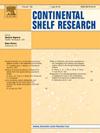Horizontal and vertical distribution of fish larvae in the main entrance of Bahía de La Paz, Gulf of California (October 2022)
IF 2.2
3区 地球科学
Q2 OCEANOGRAPHY
引用次数: 0
Abstract
Bahía de La Paz, characterized by high biological diversity, presents an intense interchange with the Gulf of California, where Alfonso Basin is located. Horizontal and vertical distribution of fish larvae in the Alfonso Basin was analyzed in relationship with the water column structure during October 2022. Two water masses were registered, the Gulf of California Water mass, from 140 m depth to surface, and Subtropical Subsurface Water mass, below the first water mass. Fish larvae were collected from three depth layers: the surface mixed layer, the oxycline and the hypoxic layer, which is characterized by low dissolved oxygen concentration (<44 μmol kg−1). The highest average density of fish larvae (27.9 larvae per 100 m3) was in the surface mixed layer. Sixty-four taxa were recorded in this layer with Benthosema panamense, Selar crumenophthalmus and Syacium ovale as the dominant species. In the oxycline a mean density of 7.4 larvae per 100 m3 was recorded with 40 taxa. Triphoturus mexicanus, B. panamense and Vinciguerria lucetia were the dominant species. The lowest mean larval density was (1 larvae per 100 m3) in the hypoxic layer, where only 4 taxa were recorded. Results showed that the highest density and richness of larvae were found in the mixed and oxycline layer, where the Gulf of California Water was observed, contrasting with the low presence of larvae in the Subtropical Subsurface Water domain, water mass characterized by low dissolved oxygen concentration. Its vertical expansion in the main entrance of the Bahía de La Paz, might constrain the fish larvae distribution and survival.
加州湾Bahía de La Paz主入口鱼类幼虫的水平和垂直分布(2022年10月)
Bahía de La Paz的特点是生物多样性高,与Alfonso盆地所在的加利福尼亚湾有密切的交流。分析了2022年10月阿方索盆地鱼类幼虫水平和垂直分布与水柱结构的关系。记录到两个水团,加利福尼亚湾水团,从140 m深度到地面,亚热带次表层水团,在第一个水团以下。从表层混合层、氧层和低氧层3个深度层采集鱼苗,低氧层溶解氧浓度较低(44 μmol kg−1)。鱼苗平均密度以表层混合层最高,为27.9条/ 100 m3;该层共记录到64个分类群,优势种为Benthosema panamense、Selar crumenophthalmus和Syacium ovale。氧斜层40个类群平均密度为7.4只/ 100 m3。优势种为墨西哥三角龙、巴拿马白背龙和白刺龙。低氧层平均幼虫密度最低(1只/ 100 m3),仅有4个类群。结果表明,在加利福尼亚湾水域的混合氧斜层中幼虫密度和丰富度最高,而在以溶解氧浓度低为特征的亚热带次表层水域中幼虫数量较少。它在Bahía de La Paz主入口的垂直扩张,可能会限制鱼类幼虫的分布和生存。
本文章由计算机程序翻译,如有差异,请以英文原文为准。
求助全文
约1分钟内获得全文
求助全文
来源期刊

Continental Shelf Research
地学-海洋学
CiteScore
4.30
自引率
4.30%
发文量
136
审稿时长
6.1 months
期刊介绍:
Continental Shelf Research publishes articles dealing with the biological, chemical, geological and physical oceanography of the shallow marine environment, from coastal and estuarine waters out to the shelf break. The continental shelf is a critical environment within the land-ocean continuum, and many processes, functions and problems in the continental shelf are driven by terrestrial inputs transported through the rivers and estuaries to the coastal and continental shelf areas. Manuscripts that deal with these topics must make a clear link to the continental shelf. Examples of research areas include:
Physical sedimentology and geomorphology
Geochemistry of the coastal ocean (inorganic and organic)
Marine environment and anthropogenic effects
Interaction of physical dynamics with natural and manmade shoreline features
Benthic, phytoplankton and zooplankton ecology
Coastal water and sediment quality, and ecosystem health
Benthic-pelagic coupling (physical and biogeochemical)
Interactions between physical dynamics (waves, currents, mixing, etc.) and biogeochemical cycles
Estuarine, coastal and shelf sea modelling and process studies.
 求助内容:
求助内容: 应助结果提醒方式:
应助结果提醒方式:


